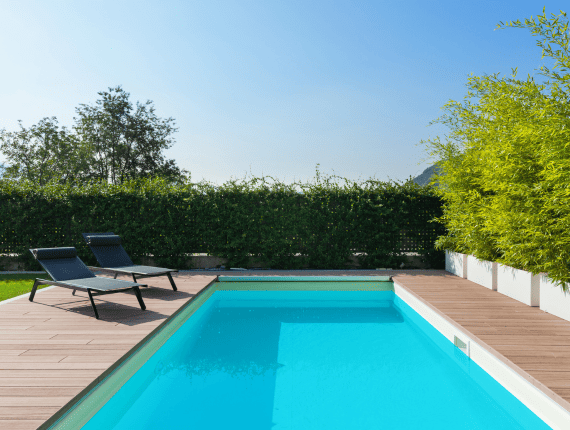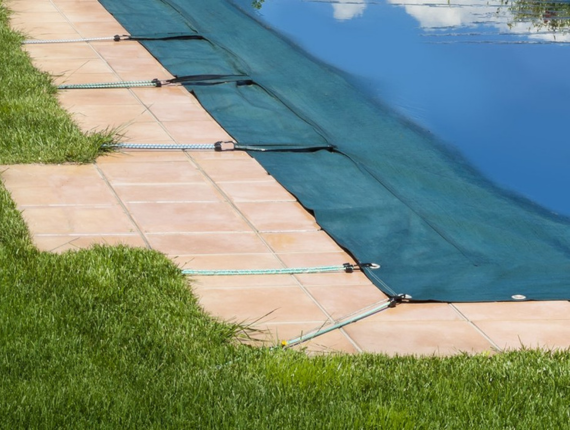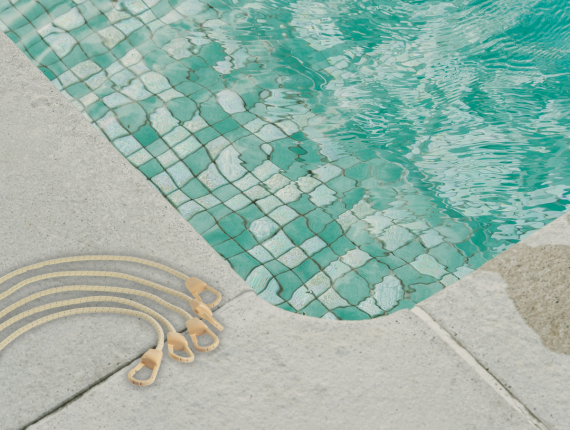Properly securing a pool cover is essential to ensuring the safety and cleanliness of a pool.
The choice of bungee cord plays a key role in the performance of the installation. If it is too loose, it jeopardizes the stability of the tarpaulin. If it is too rigid, it can damage it prematurely or tear it.
For many years, Eurosandow has been supporting tarpaulin manufacturers, swimming pool builders, and leisure professionals with tailor-made technical solutions adapted to the constraints of the outdoor environment: temperature variations, UV rays, humidity, chlorine, etc.
On this page, we share our expertise with you to help you make an informed choice:
- Which material should be preferred for prolonged outdoor exposure?
- What dimensions and diameter should you choose depending on your type of tarpaulin?
- Which terminations will ensure reliable connection?
Why use bungee cords to secure a pool cover?
Bungee cords are essential for ensuring that a pool cover stays securely in place.
Unlike a rigid fastening, an elastic tensioner provides constant tension, allowing the tarpaulin to remain perfectly in place, even in windy or rainy conditions or when temperatures fluctuate.
Thanks to their elasticity, bungee cords naturally compensate for movement and load variations (water, leaves, wind). This prevents deformation of the tarpaulin and reduces the risk of it coming loose.
Easy to install, elastic tensioners are an economical solution for effectively securing a pool cover.
The bungee cords are easy to install using end fittings (hooks, loops, end caps) that fit the eyelets on the tarp or the pitons anchored in the coping stones. This system provides quick and even tensioning.

What are the prerequisites to consider when choosing a pool cover bungee cord?
Choosing the right bungee cord for a pool cover is not simply a matter of selecting a standard elastic tensioner. To ensure effective, durable, and secure fastening, several technical criteria must be taken into account from the outset.
Dimensions de la bâche à fixer
Type de bâche
Type de fixations
La taille de la bâche influence directement la longueur et le diamètre du sandow à utiliser. Pour fixer des bâches de petite à moyenne taille, un tendeur de 6 à 8 mm de diamètre peut suffire.
Les bâches d’hivernage pour piscines, conçues pour protéger le bassin en hiver, sont généralement plus lourdes et plus épaisses que les couvertures classiques. Leur manipulation peut s’avérer délicate, d’autant plus qu’elles doivent supporter les accumulations d’eau de pluie, de feuilles ou même de neige. Ces charges supplémentaires augmentent considérablement la tension exercée sur les points de fixation. Il est donc essentiel d’opter pour des sandows tendeurs robustes, capables de garantir un maintien fiable et durable dans des conditions exigeantes.
Les bâches à bulles, principalement utilisées durant la saison estivale, sont conçues pour limiter l’évaporation, conserver la chaleur de l’eau et protéger le bassin des impuretés. Leur structure légère, bien différente de celle des bâches d’hivernage, permet une manipulation plus aisée. Pour les fixer efficacement, des sandows tendeurs de dimensions standard suffisent généralement à assurer une tenue stable sans nécessiter de contraintes mécaniques importantes.
Un sandow, aussi robuste soit‑il, ne remplira correctement sa fonction que si les terminaisons sélectionnées sont parfaitement adaptées au mode de fixation de la bâche et au support d’ancrage.
La couverture d’une piscine est généralement fixée au sol à l’aide de pitons ou de pitons avec douille scellés dans la margelle, la terrasse ou le gazon.
Un embout mal choisi crée un point de faiblesse : un crochet trop petit risque de se déformer ou de se rompre ; un œillet inadapté peut cisailler le sandow ; une boucle textile mal dimensionnée peut compromettre la tension de la bâche.
Choisir un ensemble « sandow + terminaison + support » cohérent permet de répartir les efforts, de prolonger la durée de vie de l’installation et de garantir la sécurité autour du bassin.
Pour fixer efficacement une couverture de piscine, nous préconisons l’utilisation de tendeurs équipés de crochets en acier surmoulés en plastique. Le surmoulage offre une double protection : elle préserve le crochet de l’humidité et des agents chimiques (comme le chlore), tout en évitant l’apparition de corrosion.
Which bungee cords are best suited for securing a pool cover?

choice of manufacturing materials
The elastic tensioners used to secure tarpaulins are generally composed of a natural latex core, a material known for its elasticity. This core forms the heart of the bungee cord and gives it its tensile strength and ability to absorb tension.
It is then covered with a braided polyethylene sheath, a technical material that offers excellent resistance to UV rays, humidity, temperature variations, and abrasion.
Choosing the dimensions of the bungee cord
The choice of bungee cord length depends directly on its use and the configuration of the installation, in particular the distance between the tarpaulin and the attachment points (pitons, plates, studs, etc.).
For certain applications, such as attaching a tarpaulin to a roller using a tilting end piece, bungee cords up to 150 cm long can be used. This type of mounting ensures sufficient tension while providing the flexibility needed for rolling.
Conversely, shorter bungee cords, approximately 20 cm long, are perfectly suited to more compact installations with closely spaced anchor points.
Our range of bungee cords designed for swimming pools
MINOR hook loop
Available in lengths of 50, 60, or 70 cm, with a diameter of 6 mm.
Tilting end tensioner
Available in several lengths (from 15 to 150 cm) to suit all pool configurations. Perfect for attaching the cover to a roller or offset supports.
Tilting end cap – Cabiclic
Versatile and easy to install product, with plastic hooks suitable for different fastening systems.
SPPE tensioners with or without loops
Equipped with molded hooks and compliant with standard NF P 90308, these products ensure optimal safety for winter covers. Available in lengths from 50 to 70 cm, with a diameter of 8.5 mm.
All our models are available in different lengths and diameters to suit all pool configurations. The choice of materials, finishes, and rigorous testing of our products ensure a durable solution that complies with safety requirements.
What are the standards for securing a pool cover?
Pool safety is governed by strict regulations. In France, standard NF P 90-308 applies specifically to safety covers. It defines the requirements for the strength, performance and reliability of covers, as well as the associated fastening systems.
To be compliant, a tarpaulin and its fastenings must be able to prevent the accidental immersion of a child under 5 years of age, without risk of tearing, unfastening or lifting.
In particular, it is specified that after being subjected to an impact of 50 kg, the anchoring device on the beach must not be damaged.
The bungee cords used must therefore have technical properties, particularly sufficient strength to hold the tarpaulin in place.
When designing our elastic tensioners, the elongation and return force required to stretch the elastic are defined to perfectly suit a given application.
Our products, which comply with standard NFP90308, therefore perfectly meet the safety and durability criteria required to guarantee a solid and secure installation.


Development of a bungee cord designed for pool covers
The FIX COVER® bungee cord, a result of Eurosandow’s research, is a technical bungee cord dedicated to fastening pool covers.
The elastic tensioner cable is covered with polyethylene, providing additional protection against moisture, chemicals and general wear and tear.
For bungee cords requiring hooks, we use steel hooks overmoulded with plastic. This design prevents rust and ensures better durability and safety.
This bungee cord is part of the highly technical range marketed through our network of swimming pool professionals.
FAQ
What are the conditions of use for a bungee cord manufactured by Eurosandow?
Unless otherwise specified, our products should not be used beyond 75% elastic elongation.
Our products should be used with common sense and without taking unnecessary risks. Our products should no longer be used if signs of wear are visible.
Eurosandow accepts no liability for specific installations involving our products.
What are the signs of wear and tear to look out for on a bungee cord?
Cracks in the sheath, loss of elasticity, deformed or oxidised hook: any signs of wear and tear should lead to replacement.
Can the length of the bungee cords be customised?
Absolutely. For any specific application, our design office can design fully customised tensioning bungee cords. Based on your specifications, we develop prototypes adapted to your technical constraints and your environment of use. Once the prototypes have been approved, we launch mass production, guaranteeing quality and compliance with your requirements.
Can the colour of the bungee cords be customised?
Yes, customisation of colours is possible. We offer a colour chart with over 70 shades for polyester bungee cords, available in quantities of 300 metres or more. Upon request, we can also look into customising other materials such as polyethylene, polypropylene or polyamide. For specific needs or the development of custom colours, our teams will work with you to ensure a result that matches your visual identity or usage requirements.
